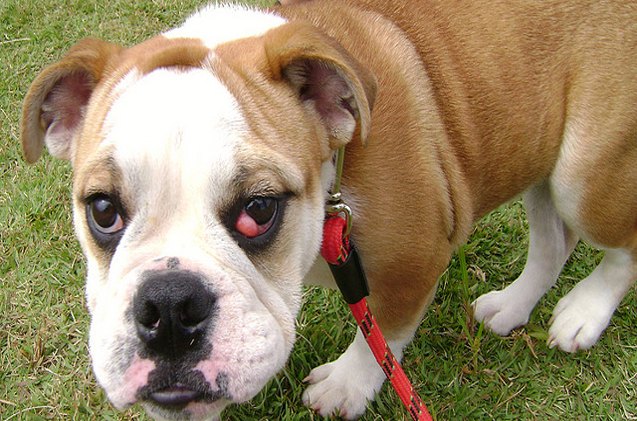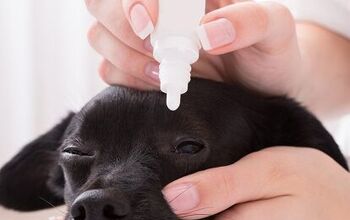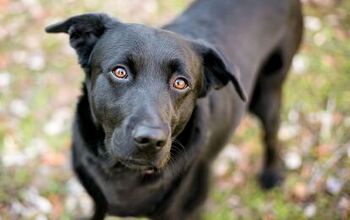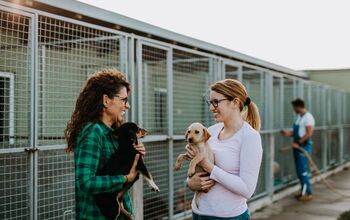What Is Cherry Eye In Dogs?

Did you know your dog has three eyelids? Most people don’t – that is, until Fido develops cherry eye. But let’s go back to that third eyelid… This clear lid is called a nictitating membrane, and it houses the glands that are vital to your dog’s vision through their tear production. So, it turns out this thing you never even knew existed is actually pretty important. Cherry eye is common in young dogs under the age of one or two, and has a prevalence in certain breeds, most of them small in size and stature. Breeds such as Lhasa Apso, Boston Terrier, American Cocker Spaniel, the English Bulldog, or the Shih Tzu are especially prone to this issue, but not exclusive to it.
Cherry eye in dogs occurs when this tear gland pops out, so to speak, appearing as a red bulge in the corner of the eye – much like a cherry, hence the condition’s name. When you see it, you’ll know what we’re talking about. The meaty mass is often accompanied by abnormal tearing and oozing. What is more, both eyes can develop cherry eye issue, but at different stages in your dog’s life. Still, it isn’t a reason for excess worry, as solutions are often simple and efficient, especially if the issue is caught early on.
Related: What You Need To Know About Glaucoma In Dogs
Cherry Eye is the Pits
Cherry eye is common in young dogs under the age of two, particularly in smaller breeds including the Cocker Spaniel, Lhasa Apso, Shih-Tzu, Pug, Poodle, Beagle, Bulldog, Boston Terrier and Bloodhound. What causes it? No need for pet-parent guilt here, your pooch was probably born with a weak ligament that attaches the gland to the membrane, which can cause the gland to literally flip out. When displaced, the gland doesn’t circulate blood properly and thus, swells, reddens, and becomes a big, ugly eye-blob.
While certainly gross looking, cherry eye itself isn’t painful – except maybe to your dog’s ego. Ouch! But the longer it’s untreated and the gland left exposed, the higher the risk of your dog developing inflammation, infection, and damage that can compromise tear production and vision down the road. The one major side effect that you will notice is an overproduction of tears. Breeds such as the bulldog are already prone to excess tears – but if a cherry eye appears, this production of tears quickly becomes abnormal.
Related: Living Well With Your Blind Dog
There are currently no known preventative measures for cherry eye in dogs, but there are treatments once it does happen that will prevent this often-recurring condition from “popping out” again. Back in the day, before the importance of this tear gland was fully understood, the treatment for the protrusion was to simply remove it. But the “when in doubt, take it out” cure-all is not ideal, knowing what we now know. After all, it was put there for a reason, right? Removal of the gland, which produces approximately 40 percent of the eye’s tears, can result in dry eye, discomfort, and a medication regime from here on in. Short of lopping off the offending protrusion, there are some other treatment options that could do the trick.
Topical versus Surgical Treatment
If caught early, the gland can sometimes be eased back into place using manual massage and manipulation, antibiotics or steroids, and in some cases, cherry eye in dogs sometimes just corrects itself. Of course, manual treatment sounds ideal: spot the third eye early on and you can apply gentle massage movements in a downward and diagonal direction. As you massage towards the snout, with your pet’s eyes closed, you can gently ease the gland back into place and fix the issue. At times, antibiotics and steroids will be enough too. What is more, the cherry eye can sometimes fix itself! But in all these cases, since you’re not actually fixing the weakest link, the chances of a relapse prolapse within days or even hours are pretty high. So, either bone up on your eye massaging abilities, or consider surgical treatment as a more permanent solution to the problem.
The “pocket’ or “envelope” technique tops the charts as the most common procedure, according to the American College of Veterinary Ophthamologists. As the name suggests, it involves cutting a new pocket in the third eyelid, tucking the gland back into place, and stitching the pocket shut to the gland doesn’t sneak back out again. Viola! Alternately, the gland can also be tacked to the orbital rim to secure it in place. Unfortunately, each surgery comes with risks and none offer a 100 percent guarantee that this recurring problem will be corrected once and for all.
Sure, this procedure with cutting and stitching doesn’t sound too appealing, especially for your pupper. But in the hands of a skilled and seasoned vet, this procedure can be considered safe, quick, and efficient. If the hand massage, antibiotics, or steroids don’t help – or the gland prolapse keeps recurring, this simple surgery might be the last and ideal solution.
Whatever the solution you opt for, aftercare will be necessary. This is especially important if a surgical treatment is chosen. The usual aftercare involves antibiotic eye ointment up to three times per day for a period of up to two weeks. This might vary from pet to pet and per your vet’s instructions. Still, even after surgery, a new relapse of the cherry eye is still a possibility, and will require more treatment. But this is not a reason to worry. With good care the problem can be solved and your doggo can live a normal life.
Lydia McNutt is an award winning writer, editor, blogger and proud mama of three of the fur-babies: her two cats, Phoebe and Brewster (who think they are dogs,) and her 90-pound yellow lab, Fred – the biggest lap dog you’ll ever meet. When her head’s not in a cloud of fur, you’ll find Lydia chasing her toddler through the neighborhood, reading a good biography, or writing about… Well, you’ll just have to read more of Lydia’s articles to find out!

More by Lydia McNutt
























